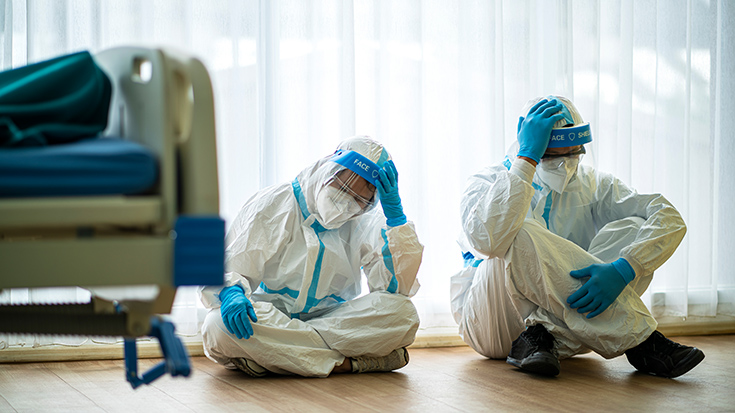
Philips RS North America Agrees to Resolve False Claims Issue
According to the Department of Health and Human Services, Philips RS North America LLC will pay more than $24 million to resolve False Claims Act allegations that it mislead federal health care programs by paying kickbacks to DME suppliers.
Medicare, Medicaid, and TRICARE, the health care program for members of the military and their families, were affected by the misleading actions.
Philips RS North America was formerly known as Respironics, Inc. Read More
Face Mask Recall
The FDA is alerting patients, caregivers, and health care providers to a recall of certain masks used with bilevel PAP machines and CPAP machines. The recall was issued by Philips Respironics and is due to a serious safety concern that the magnets used in the masks may affect the functioning of implanted metallic medical devices or metallic objects in the wearer of the mask or a bed partner.
So far, 14 serious injuries related to the problem have been reported by Philips, including pacemaker failure, arrhythmia, seizures, and irregular blood pressure.
The five masks affected by the recall are the DreamWisp, DreamWear, Amara View, Wisp, and Wisp Youth masks. Read More
Omicron-Specific Boosters Authorized by the FDA
The long-awaited COVID-19 booster shots targeting the newer versions of the virus are on their way. The FDA amended the emergency use authorizations for both the updated Moderna and Pfizer-BioNTech vaccines on Aug. 31.
The vaccines will be available for use in a single booster dose at least two months following primary or booster vaccination. Each of the shots includes an mRNA component of the original strain to provide an immune response that is broadly protective against COVID-19 and an mRNA component in common between the omicron variant BA.4 and BA.5 lineages to provide better protection against COVID-19 caused by the omicron variant.
The Moderna shot will be available to those 18 years old or older. The Pfizer shot will be available to those 12 years old and older. Read More
Transitions Bundle Reduces Readmissions for COPD Patients
A multicenter, randomized controlled trial involving 4,000 patients in Canada has shown significant value for a transition bundle in reducing hospital readmissions for patients with COPD. The bundle components were implemented by a variety of clinicians, including RTs, and included these seven key elements —
- Patient demonstrates adequate inhaler technique.
- Discharge summary sent to the patient’s family physician and a follow-up visit arranged.
- Respiratory medications optimized and reconciled before discharge.
- Provide patient with a written discharge management plan and assess patient or caregiver for comprehension of discharge instructions.
- Refer to pulmonary rehabilitation (if agreeable and meets eligibility criteria).
- Screen for frailty and comorbidities.
- Assess for smoking status and provide counseling or referral for smoking cessation.
The study compared outcomes for patients who were and were not exposed to the transition care bundle during their hospitalization. Results showed patients who received the bundle were 83% less likely to be readmitted within seven days of discharge and 26% less likely to be readmitted within 30 days. No change was seen in 90-day readmissions.
Adding a care coordinator to follow up with patients at home didn’t deliver any added benefit, aside from the fact that 7.6% more patients visited a primary care physician within 14 days of discharge.
The bundle was associated with a 7.3% increase in length of stay and a 76% increased risk of a 30-day revisit to the emergency department. The researchers speculate the increase in ED visits may have been due to greater symptom awareness among the patients who received the transition bundle. It could have also been influenced by limitations in access to primary care.
The study was published by CHEST. Read More
Hamilton Medical Recalls ICU Ventilator
According to the FDA, Hamilton Medical AG is recalling the HAMILTON-C6 Intensive Care Ventilator.
The company decided to recall the device after customer complaints revealed a hardware issue with the ventilator’s status indicator board. Specifically, the board may become loose, allowing liquid to enter (ingress) between the indicator board and the ventilator’s main board, causing the ventilator to have a technical fault, causing it to revert to a safety ventilation mode or to an ambient state.
In the ambient state, an alternative source of ventilation must be provided immediately. If not, the patient may experience interrupted ventilation, brain injury caused by lack of oxygen to the brain (hypoxia), a buildup of carbon dioxide in the blood (hypercarbia), other serious injuries, or death.
There have been 128 complaints worldwide associated with the issue, but no injuries or deaths. Read More
New Role Seen for Nitric Oxide in Asthma Care
Could nitric oxide hold the key to improving drugs used to treat constricted airways in asthma? Researchers from University Hospitals and Case Western Reserve University believe the answer may be yes.
A study conducted on mice found that nitric oxide is a key molecule in the β2-adrenergic receptor (β2AR) feedback loop. Specifically, the production of nitric oxide after β2AR stimulation mediates airway relaxation. However, overproduction of the molecule also inactivates β2AR, leading to bronchoconstriction.
The study found similar results for other G protein-coupled receptors, including the β1 adrenergic receptor and the angiotensin II receptor 1.
“Nitric oxide should be thought of as a key new player in how this class of receptors works,” said study author Jonathan S. Stamler, MD. “It’s responsible for both the beneficial effects of the receptors and for turning them off. And if you can understand how they’re being turned off — how that nitric oxide is popping on to the receptor — and you can block that, you’re going to be left with a new pathway for opening airways. The next step in our research will focus on leveraging this new pathway therapeutically.”
The study was published by Molecular Cell. Read More
Remote Patient Monitoring with Health Coaching Improves Outcomes for COPD Patients
Remote patient monitoring (RPM) with health coaching led to fewer emergency department visits among COPD patients taking part in a 12-week trial conducted by researchers from the Mayo Clinic and the University of Minnesota. The 375 patients in the study were randomized to either the RPM system or usual care.
Following study, the patients took the Chronic Respiratory Questionnaire (CRQ), which uses quality of life (QoL) as the primary unit of measurement. Results showed steeper improvements in CRQ scores among those in the intervention group, and those patients were also significantly less likely to have made a trip to the ED, 8.8% vs. 16.9%.
All CRQ domains showed a positive impact, including self-management, daily physical activity, sleep, and depression. The changes were maintained at a 24-week follow-up.
The authors conclude, “Remote monitoring with health coaching promotes COPD wellness and behavior change given its effect on all aspects of QoL, self-management, daily physical activity, sleep, and depression scores. It represents an effective option for home-based rehabilitation.”
The study was published in the Annals of the American Thoracic Society. Read More
Thirdhand Smoke Exceeds California Guidelines
Toxic chemicals found in thirdhand smoke — defined as cigarette smoke that lingers on clothes and other surfaces long after airborne smoke has dissipated — exceed risk guidelines established by the State of California. This discovery is according to researchers from the U.S. Department of Energy’s Lawrence Berkeley National Laboratory.
The finding suggests nonsmokers can still be exposed to the health risks of smoking simply by living in contaminated spaces.
The study was conducted using data from earlier studies on thirdhand smoke and new data on how these chemicals can enter the human body through inhalation, dust ingestion, and the skin. The researchers plan to explore how these exposures may lead to adverse health effects.
Investigators from the University of California San Francisco, the University of California Riverside, and San Diego State University collaborated with the Berkeley Lab on the study.
The research was published by Environmental Science & Technology. Read More
Email newsroom@aarc.org with questions or comments, we’d love to hear from you.














